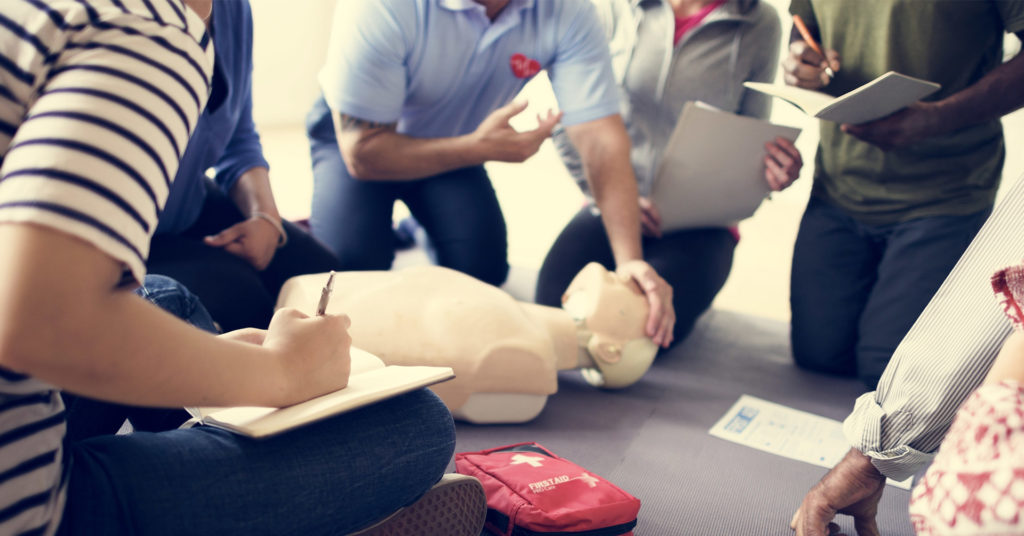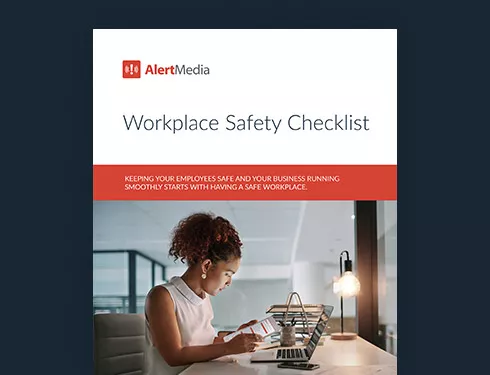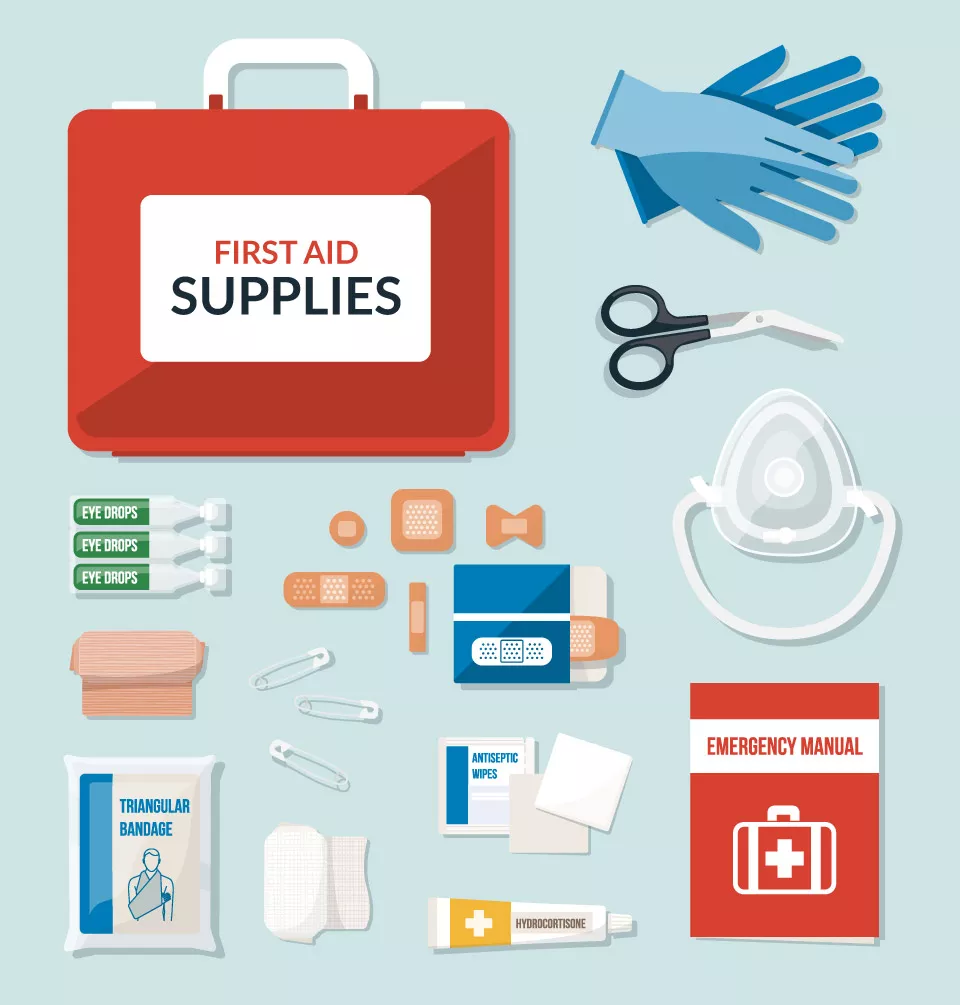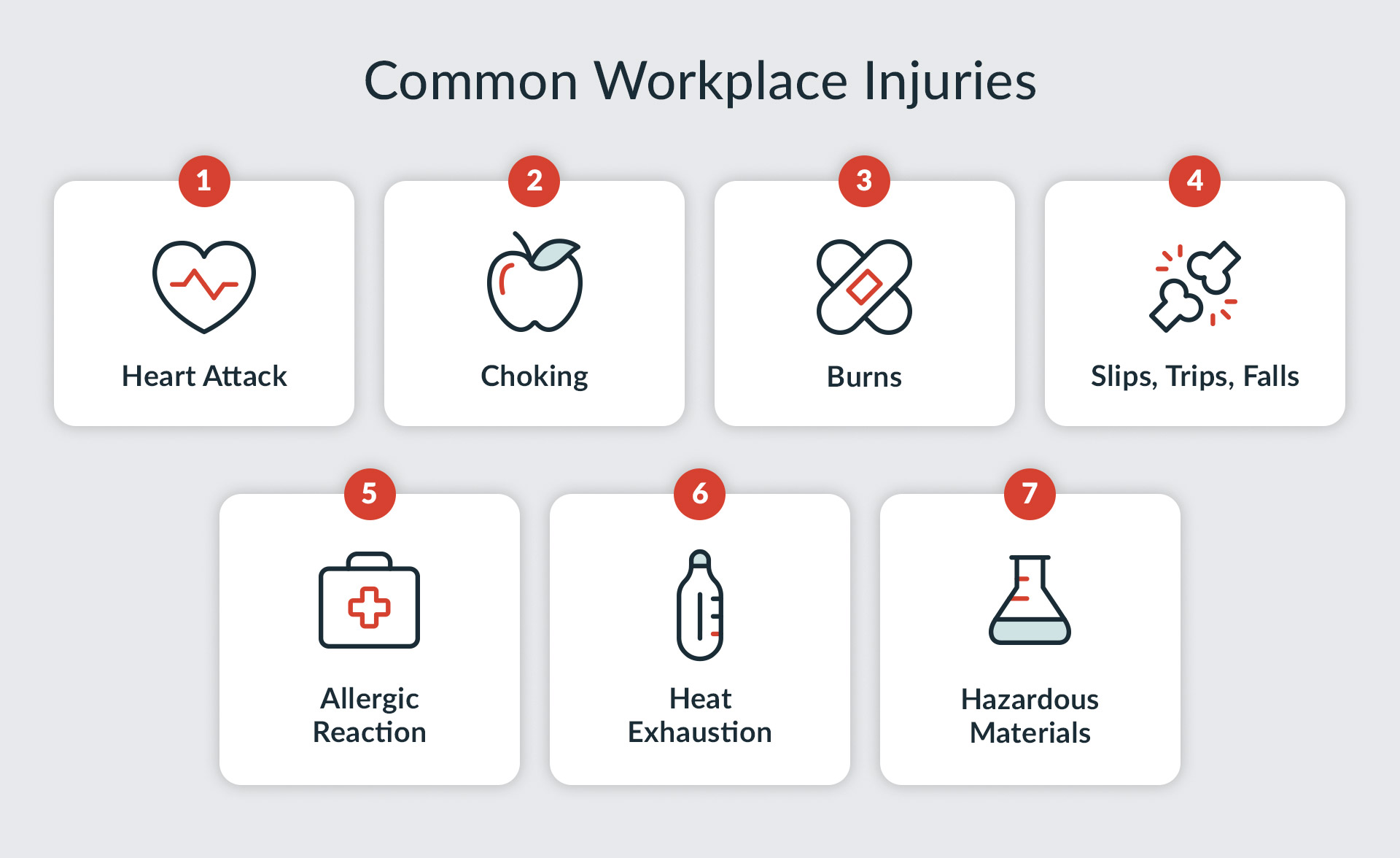
Your Comprehensive Guide to First Aid Training for Employees
All employees are exposed to a range of risks every single day. But first aid training can prepare your team to respond to workplace injuries and will help them stay safe on the job.

Whether your employees work in an office or on a construction site, they’re exposed to a range of risks every single day. If someone trips over an exposed cable or falls from a high level—would other employees know how to administer first aid? Preparing your team to respond to workplace injuries effectively is key to helping them feel safe.
In fact, safety at work is something today’s workforce values more than almost any other workplace incentive. Creating a robust first aid training strategy for your company can help you provide fast and effective care if an employee experiences an illness or injury at work, improving health and safety outcomes. And it’s not just employee wellbeing that’s on the line—employers lost 99 million days of labor as a result of work-related injuries in 2020.
In this article, we’ll explore how to develop and conduct practical workplace first aid training, empowering your employees to administer first aid with confidence and clarity.
Identify Your Company’s First Aid Training Needs
Organizations require different types of first aid training depending on the industry, workplace locations, and specific risks to which their employees are exposed.
Here are three steps to determine the most effective first aid training for your leaders and employees:
1. Assess likely threats and risks
When evaluating your first aid training needs, the first step is to identify and assess the risks specific to your company. Conducting a business threat assessment can help you understand the specific safety hazards your people may face—in specific locations and specific occupations. For companies with more than 10 employees, the Occupational Safety and Health Administration (OSHA) injury and illness recordkeeping forms are also a great way to gauge your organization’s safety performance and any incident patterns. A review of workers’ compensation claims can trigger insightful questions: Which injuries occur most often in your workplace? Are these occurrences above industry averages, and if so, do you know why?
2. Comply with industry standards
Certain high-risk industries require first aid training over and above what’s needed for lower-risk workplaces. For example, OSHA doesn’t require companies in most industries to complete basic life support (BLS) training, including cardiopulmonary resuscitation (CPR) using an automated external defibrillator (AED). But this training is compulsory for workers in specific industries, including logging and electric power generation, where the risk of workers suffering from a heart attack is higher. By understanding the scope of first aid requirements, you can be sure your training program is compliant and make intentional choices about offering curated trainings beyond the standard.
3. Align training with your duty of care
Creating a positive safety culture where every employee is valued is a vital component of an employer’s duty of care—your obligation to protect your employees and provide a safe work environment. But does your current training meet those objectives? Only 38% of Americans say they know what to do during a workplace emergency. Developing robust first aid training can help ensure employees know how to swiftly and adequately react to a first aid emergency at work, improving safety outcomes for themselves and others.
Once you have a firm idea of your company’s first aid training needs, you can move on to designing effective programs for employees at every level of the organization.
Is First Aid Readiness Required by OSHA?
OSHA recommends—but doesn’t always require—that a workplace should include at least one employee trained and certified in first aid, including CPR.
The OSHA requirements are broad—but standard 1910.151 states that employers must ensure medical personnel are available to staff for advice and consultation. The general first aid standard is often achieved by training at least one staff member in first aid, but having a nearby hospital or clinic for treatment is also acceptable.
Most businesses choose to train multiple employees—and in this case, OSHA states that the training needs to be workplace-specific. For some high-risk industries, first aid and CPR training for employees is required by OSHA.
Establish First Aid Training Programs for Employees, Groups, and Leaders
Tailor your first aid training program to the industry and employee job functions across the company. Consider specific training curricula for employees providing general first aid, groups facing unique risks, and workplace safety leaders. Commit to thoughtful training design, implementation, and maintenance so the knowledge sharing is up to date with common best practices and workplace changes.
Individual employees
While OSHA states that only one employee needs to be trained in first aid, in reality, most companies choose to train multiple staff members. Doing so ensures there’s always someone available to respond to ill or injured employees. The size and structure of your company will dictate which employees you decide to train as first aid providers.
A range of organizations deliver first aid training courses:
- American Red Cross
- National Safety Council (NSC)
- American Heart Association
- Private institutions
Make sure any provider follows the National Guidelines for First Aid Training in Occupational Settings (NGFATOS). These guidelines contain the essential elements to help employees become comfortable administering first aid. Courses are often delivered using onsite training, but online training is sometimes an option for introductory or refresher courses.
First aid training will usually include the following elements:
- Preparing to respond to a health emergency
- How to respond to life-threatening emergencies
- How to respond to non-life-threatening emergencies
While CPR and AED training isn’t mandatory for most industries, many experts recommend including them in your basic training package. Each year, around 10,000 people suffer from cardiac arrest while at work. Waiting for emergency medical services (EMS) to arrive results in a survival rate of just 5 to 7%. In contrast, if an AED is used immediately by a cardiac first responder (CFR) trained employee, survival rates can increase to up to 60%.
Groups that face unique risks
The first aid and safety training requirements for office workers differ significantly from those for employees working in higher-risk roles. While everyone should receive a minimum level of first aid training no matter the setting, OSHA requires additional CPR training for positions and industries with greater risks of asphyxiation, electrocution, or exertion. Examples of these include:
- Permit-required confined spaces (including tanks, storage bins, silos, and vessels)
- Logging
- Electric power generation, transmission, and distribution lines and equipment (including the construction of these installations)
- Dive teams
Other unique risks you may need to provide training for could include:
- Exposure to bloodborne pathogens
- Exposure to hazardous chemicals
- Working at heights
Safety leaders
Safety leaders are often in charge of reviewing first aid trainings and adjusting course materials when necessary. Assign select leaders to manage first aid training for specific incident plans—for example, an active shooter, extreme weather event, or workplace fire—so they are better prepared to lead response plans if that type of emergency does arise.
Safety leaders should also be certified in first aid training so they can teach employees first aid basics. This can be a cost-effective way for larger organizations to offer regular training sessions.
Prepare Employees with Effective Emergency Response Skills
First aid training isn’t something you can complete once and then forget about it—it needs to be embedded into the overall safety culture of your company. But how do you make sure these emergency response skills are effective? Again, it comes down to training. Regularly revisiting safety topics like first aid will ensure your employees are prepared when they need to react quickly.
You may decide to run monthly training sessions on various safety topics, including first aid. This keeps skills up to date so your employees can confidently respond to a real-life situation.
Open communication fosters employee buy-in
Make sure your employees know why—and how—you plan to keep them safe. Asking people for their input can help them feel involved. Survey your employees and ask them what they hope to achieve from their first aid training. Are there any specific topics they’d like you to cover? Could they benefit from additional first aid supplies in certain locations? Does everyone know who’s trained to administer first aid and how to contact them in an emergency?
Practice makes perfect
Regular training reinforcement or “retrieval practicing” helps employees retain information from their training sessions. OSHA estimates that most employees retain the skills learned during first aid training for 6 to 12 months.
If an accident occurs, you want your employees to administer first aid correctly—and that skill takes regular practice. Basic CPR skills should be re-tested annually, while first aid skills should be reviewed and updated at least every three years but preferably more often. Between these mandatory sessions, you can also organize micro-learning sessions to consolidate and refresh knowledge.
Conducting tabletop exercises is a great way to practice simulated scenarios and evaluate preparedness with an after-action report. You should also regularly review your emergency response plan and update it as new risks emerge that could threaten the safety of your employees.
Clearly state your expectations
Let your people know how you’ll deliver first aid training, when, and to which employees. While it’s a good idea to have a minimum number of employees qualified to administer first aid, you may find that others are keen to complete this training too. Integrate regular feedback cycles to discover whether people find the training valuable and if there’s anything else they’d like to learn.
Review your training regularly to respond to changes in best practices, equipment updates, or new workplace hazards. As you evaluate and assess risks, new guidance or training may be needed to cover threats your employees haven’t been exposed to in the past.
Make Sure Your Facilities Are Well Equipped
Training is vital—but so is providing basic first aid kits for your worksite and other supplies needed during specific emergencies. OSHA and the American National Standard for Minimum Requirements for Workplace First Aid Kits and Supplies (ANSI) both offer guidance on what needs to be included.

Updates to these guidelines mean you may need to revise your first aid kit and add items over time. Recent additions have included foil blankets and updated tourniquet guidance. Safety leaders should regularly review kits to ensure there are always adequate first aid supplies. The quantities of each item will depend on how many employees are on-site and the type of workplace hazards they are most likely to face.
Protecting Your Most Valuable Asset
First aid training is one of the best ways to protect and promote the safety and well-being of your employees. Research by the American Heart Association also reveals that more than 65% of employees across industries say that they would view their employers more positively if they offered CPR/AED or first aid training. And yet, 55% say their employers don’t regularly provide this training. By implementing a comprehensive first aid training strategy, you can significantly improve the safety outcomes of accidents and injuries in the workplace, boost employee morale, and reinforce your company’s commitment to a proactive safety culture.





